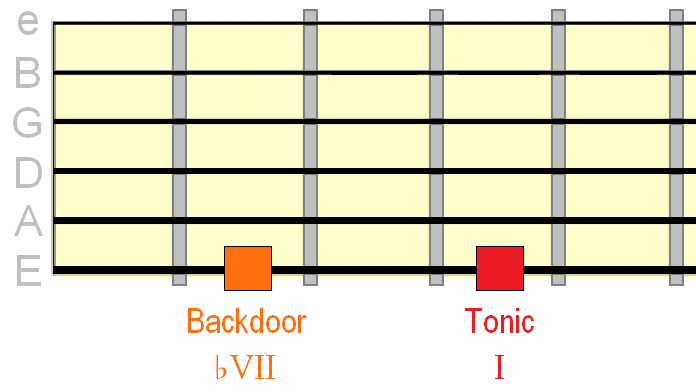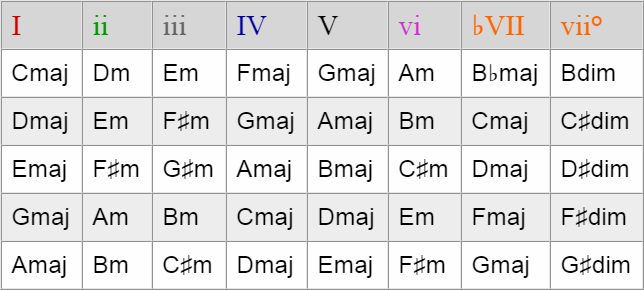Why Backdoor?
The "backdoor" refers to a particular chord position in relation to the tonic or I chord. The easiest way to think of the backdoor chord is to visualise a major chord one whole step below the tonic chord root.
For example, Dmaj would be the backdoor chord in E major. Gmaj would be the backdoor chord in A major.
So if we were playing a tonic chord shape with the bass root note on the low E string, we could visualise the backdoor chord root two frets below as follows (note: this relationship is the same no matter what string you're on)...

This means, if our progression was in the key of C major, Cmaj would be our tonic chord and B♭maj would be the "backdoor chord".
In the key of E major, Emaj would be our tonic chord and Dmaj the backdoor.
This backdoor chord can be seen in relation to the major scale as the ♭VII (flat 7th degree) chord. It's "flat" because we've taken the natural 7th degree (vii) of the major scale and flattened it by a semitone/half step.
Here's how the backdoor ♭VII would slot into the major scale in five common keys...

So effectively we've added an extra degree, and therefore chord, to the major scale in the flat 7th position (hence the numeral ♭VII).
If we were to visualise these chord degrees (the chord root notes) on the low E and A bass strings of the guitar, here's how it would appear in the key of C major (so C is our tonic root)...

Using ♭VII In a Backdoor Progression
The most common function of this ♭VII chord is as a substitute for the V chord, which is commonly used before resolving to the tonic I chord.
So instead of Dm / Gmaj / Cmaj (ii V I), we might use the backdoor approach of Dm / B♭maj / Cmaj (ii ♭VII I)
Listen to the standard ii V I above followed by its backdoor equivalent...
To enhance this backdoor cadence, musicians often play a minor iv (instead of the major IV) chord before moving to the ♭VII chord and finally returning home to I. In C major, that would be...
Fm / B♭maj / Cmaj
The above example is where the nickname backdoor ii V comes from, because the movement from iv to ♭VII implies a ii V relationship.
What this means is we can also use the relative major of the minor iv chord to signpost us through the back door...
A♭maj / B♭maj / Cmaj
You don't always have to link to the backdoor chord from iv though. Try moving from different chords to the ♭VII. For example, we could move from the vi (6) chord as follows...
Cmaj / Am / B♭maj / Cmaj
There are, of course, also instances where the "backdoor chord" is not used as the pre-tonic chord (the chord before resolving to the tonic). As we're just focusing on the backdoor cadence in this lesson, we'll cover different uses of ♭VII another time.
Chord Types Used In Back Door Progressions
Now we know the cadential function of the ♭VII chord, we can now look at some of the different chord types that work well in this position.
Tip: If you're already familiar with the V chord, any of its enhancements will also work well in the ♭VII position.
Dominant 7th, 9th and 13th Chord
The most common extension of the ♭VII triad is a dominant 7th chord, giving us ♭VII7.
Again, in C major, that would be...
B♭7 / Cmaj
Naturally, then, we can extend this to a dominant 9th and 13.
B♭9 or B♭13 / Cmaj
A nice alteration of the dominant 7th is to add a #11 (this is the same as a #4 in relation to the natural 4th in the major scale), giving us a B♭7#11 backdoor in the key of Cmaj...
B♭7#11 / Cmaj
Major 7th, 9th and 13th Chord
A lot of soul and modern R&B uses the major 7th in the ♭VII backdoor position. It carries a lot less tension than the dominant 7th variation.
Note that major 7th chords won't work so well if you're using the iv ♭VII I (backdoor ii V) cadence we looked at earlier.
But it would work nicely for a IV - ♭VII movement...
Cmaj7 / Fmaj7 / Bbmaj7 / Cmaj7
Or ii - ♭VII...
Cmaj7 / Dm7 / Bbmaj7 / Cmaj7
And just like with the dominant 7th ♭VII, we can add the #11 to give the ♭VIImaj7 a little extra spice.
Added 9th Chord
Another soulful and relaxed use of the backdoor position is to use an "add9" chord.
Cmaj / Fmaj / B♭add9 / Cmaj
Suspended Chord
Just like in the V position, you can use a suspended or "sus" chord in the backdoor ♭VII position.
It's most effective when extended. For example, here are some typical extended suspended 4th shapes we can use...
Fm7 / B♭9sus4 / Cmaj7
Fmaj7 / B♭9sus4 / Cmaj7
Tip: in that second example, I resolved the suspended backdoor chord to a dominant 9th. This adds some nice voice leading to the progression.
Obviously I can't cover every possible chord that can be used in this position, but experiment and let your ear be the judge of what sounds good.
I hope this lesson has opened your eyes (and ears) to a "new way home" your progressions can take... through the back door!
